How to Get Bigger Leaves on Monstera Adansonii? Growth Tips!
To get bigger leaves on your Monstera Adansonii, it is crucial it receives bright, indirect light, simulating a natural forest canopy. Maintain soil moisture consistently using a well-draining mix with organic matter, watering every 7-10 days during the growth season.
Keep humidity between 60% and 80%, employing a humidifier if necessary. Fertilize with a balanced 20-20-20 NPK formula bi-weekly.
Prune regularly to direct plant energy to larger leaves, using sterilized tools to avoid pathogens. Repot every 1-2 years in a well-draining mix.
Regularly inspect for pests, using insecticidal soap or neem oil as needed. By mastering these techniques, you’ll enhance leaf size and overall plant essentiality.
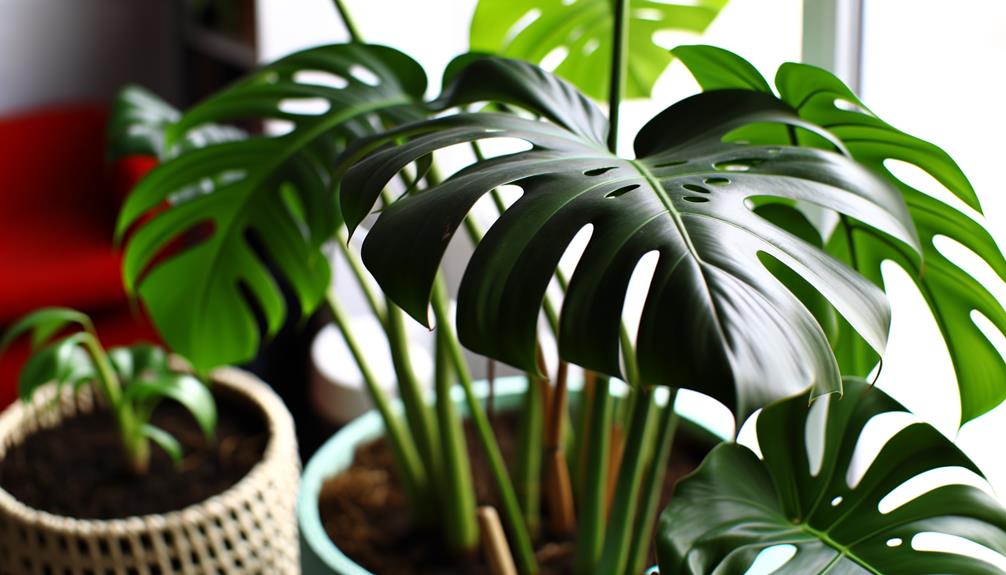
Key Takeaways
- Provide bright, indirect light to mimic natural forest canopy conditions.
- Regularly feed with a balanced 20-20-20 NPK fertilizer every 4-6 weeks.
- Maintain consistent soil moisture by watering every 7-10 days during the growing season.
- Use a humidifier or humidity tray to keep humidity levels between 60% and 80%.
- Support upward growth with moss poles or bamboo stakes for larger leaves.
Optimal Light Conditions

For Monstera adansonii to develop larger leaves, provide it with bright, indirect light as it mimics the plant’s natural habitat under the forest canopy. Empirical studies have shown that Monstera species thrive in environments where they receive filtered sunlight, which promotes prime photosynthesis without causing leaf burn.
Positioning your Monstera near a north or east-facing window can achieve these conditions. Artificial light sources, such as fluorescent or LED grow lights, can also be effective if natural light is insufficient. Ensure the light intensity is around 1000-2000 foot-candles for ideal growth.
Avoid direct sunlight, as it can cause photoinhibition, leading to stunted leaf development. By replicating these light conditions, you’ll encourage your Monstera adansonii to produce larger, healthier leaves.
Proper Watering Techniques
Ensuring consistent moisture levels in the soil is critical for Monstera Adansonii‘s leaf development. Empirical evidence suggests that variability can stunt growth. Monitor your watering frequency to maintain a perfect balance, avoiding both drought and waterlogging.
Proper drainage methods are essential for this plant. Using well-draining soil and pots with drainage holes can help prevent root rot and support healthy leaf expansion.
Consistent Moisture Levels
Maintaining consistent moisture levels is essential for ensuring that your Monstera Adansonii thrives, as it directly impacts the plant’s nutrient uptake and overall health. Water availability influences the osmotic pressure within the plant cells, facilitating efficient nutrient transport.
Empirical evidence indicates that Monstera Adansonii performs best when its soil remains evenly moist but not waterlogged. Inconsistent watering can lead to root rot or nutrient deficiencies, inhibiting leaf growth.
Utilize a well-draining soil mix to maintain proper moisture balance. Employ moisture meters or physically check soil dampness to ensure ideal hydration. Remember, the goal is to achieve a moist yet aerated root environment, promoting robust cellular activity and, consequently, larger, healthier leaves.
Watering Frequency Tips
To enhance leaf growth in Monstera Adansonii, understanding the specific watering frequency that maintains the soil consistently moist without becoming waterlogged is crucial. Empirical evidence indicates watering every 7-10 days during the growing season, adjusting based on environmental humidity and temperature.
Use your finger to check soil moisture; the top inch should be dry before the next watering. Over-watering can result in root rot, while under-watering hinders leaf development.
Employ a systematic approach: monitor leaf turgor pressure and soil moisture levels. Using a moisture meter can provide accurate insights. Regularly review your watering schedule, as seasonal changes can impact plant hydration requirements.
This precision ensures ideal physiological conditions for expansive leaf growth.
Proper Drainage Methods
Proper drainage methods are essential for Monstera Adansonii’s health, as they prevent waterlogged conditions that can lead to root rot and hinder leaf growth. You should use well-draining soil, rich in organic matter, to facilitate aeration.
Empirical evidence shows that adding perlite or orchid bark improves drainage efficiency. Guarantee the pot has ample drainage holes to allow excess water to escape.
Additionally, avoid letting the plant sit in a saucer filled with water, as this creates a saturated environment detrimental to root health. Scientific studies indicate that consistent, proper drainage promotes vigorous root systems, thereby enhancing nutrient uptake and leading to larger, healthier leaves.
Monitoring soil moisture levels with a meter can provide more precise control over watering frequency.
Ideal Soil Mix
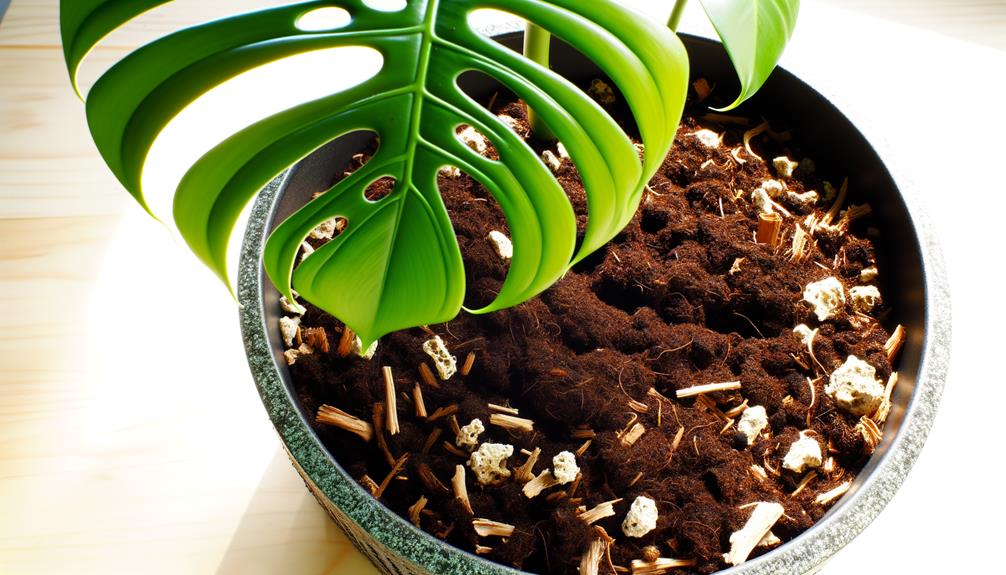
A well-draining soil mix rich in organic matter is essential for promoting the vigorous growth of Monstera Adansonii leaves. Aim for a blend that retains moisture while allowing excess water to escape, preventing root rot.
Incorporate components like peat moss, perlite, and orchid bark. These materials offer an excellent balance of aeration, drainage, and nutrient retention.
| Component | Purpose |
|---|---|
| Peat Moss | Moisture Retention |
| Perlite | Aeration |
| Orchid Bark | Drainage |
Empirical evidence suggests that this mixture provides the necessary support for extensive root development, which in turn facilitates larger leaf growth.
By ensuring your soil mix meets these criteria, you’ll create an environment where your Monstera Adansonii can thrive, producing lush, expansive foliage.
Humidity Requirements
Maintaining humidity levels between 60% and 80% significantly enhances the leaf size and overall health of Monstera Adansonii, as empirical studies indicate ideal growth under these conditions.
Higher humidity replicates the plant’s native tropical environment, promoting vigorous foliar expansion. You can measure ambient humidity using a hygrometer and adjust as needed.
Employing a humidifier or placing the plant on a humidity tray filled with water and pebbles can effectively increase moisture levels. Inadequate humidity often results in smaller, less vibrant leaves and potential leaf browning.
Regular misting can also be beneficial; however, it’s essential to ensure good air circulation to prevent fungal growth. Consistent humidity monitoring and maintenance are crucial for optimizing Monstera Adansonii’s growth parameters.
Fertilization Schedule
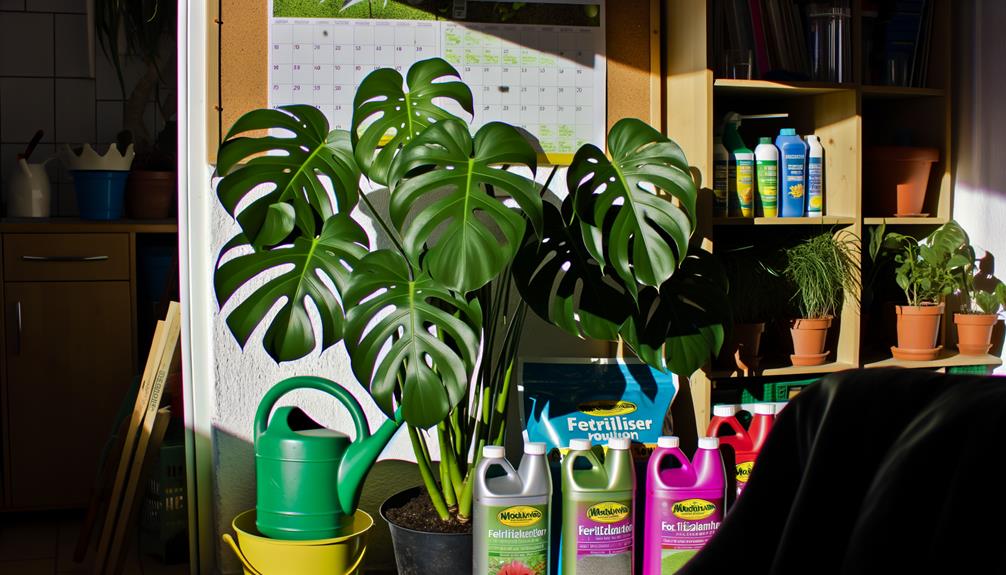
To achieve best growth in Monstera Adansonii, you need to adhere to a precise fertilization schedule that guarantees a balanced nutrient balance.
Empirical evidence suggests that feeding the plant with a balanced fertilizer every 4-6 weeks during the growing season greatly enhances leaf size.
It’s critical to adjust fertilization frequency during dormant periods, reducing it to prevent nutrient buildup and potential root damage.
Optimal Nutrient Balance
Achieving the most suitable nutrient balance for Monstera Adansonii involves following a precise fertilization schedule that guarantees the plant receives essential macro and micronutrients.
Empirical evidence suggests a 20-20-20 NPK (nitrogen, phosphorus, potassium) formula is ideal. Nitrogen promotes leaf growth, phosphorus supports root development, and potassium enhances overall plant vigor. Additionally, trace elements like magnesium, iron, and manganese are crucial for chlorophyll synthesis and enzymatic functions.
Apply a balanced liquid fertilizer bi-weekly during the growing season. Dilute to half-strength to prevent root burn and nutrient overload.
Monitor your plant’s response; yellowing leaves may indicate nutrient deficiencies, while excessive growth with weak stems can signal over-fertilization. Adjust accordingly to maintain a healthy nutrient equilibrium for achieving larger leaves.
Seasonal Feeding Times
Understanding the most suitable nutrient balance is only part of the equation; implementing a strategic fertilization schedule tailored to seasonal growth cycles guarantees Monstera Adansonii achieves its full leaf potential.
During the active growing season (spring and summer), provide a balanced liquid fertilizer every two weeks. In contrast, during the dormant period (fall and winter), reduce feeding frequency to once a month. This schedule aligns with the plant’s natural metabolic rhythms, ensuring the most advantageous nutrient uptake.
Empirical evidence highlights:
- Spring/Summer: Fertilize bi-weekly with a 20-20-20 NPK formula.
- Fall/Winter: Fertilize monthly with a half-strength solution.
- Consistency: Regular feeding during growth spurts maximizes leaf size.
- Observation: Monitor for nutrient deficiencies and adjust accordingly.
Adhering to these guidelines fosters robust, larger foliage.
Pruning and Maintenance
Trimming your Monstera adansonii regularly encourages larger leaf growth by redirecting the plant’s energy towards new, healthy foliage. Trim back leggy growth and remove any yellowing or damaged leaves. This process, known as apical dominance, stimulates the plant to produce strong lateral shoots.
Empirical evidence suggests that trimming at nodes, where leaves and stems intersect, maximizes nutrient allocation to new leaves. Use sterilized tools to prevent pathogen transmission. Research indicates that regular trimming, every two to three months, fosters best growth conditions.
Monitor the plant’s response; excessive trimming can stress the plant, inhibiting leaf size expansion. Consistent maintenance ensures your Monstera adansonii remains vibrant and capable of developing the larger leaves you’re aiming for.
Supporting Growth With Stakes
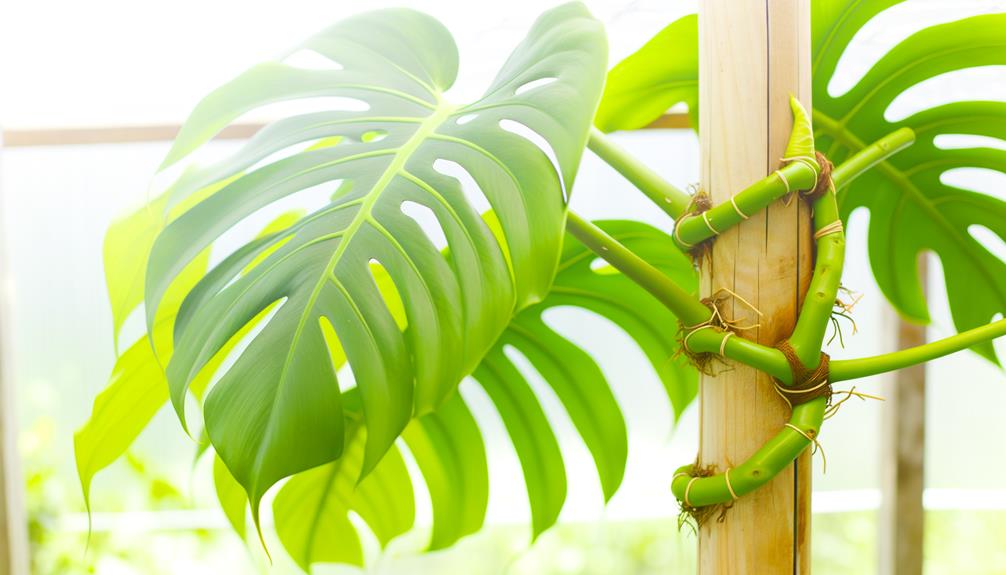
To further boost leaf growth, supporting your Monstera adansonii with stakes provides structural stability and encourages upward growth, which can lead to larger, healthier leaves. Empirical evidence suggests that aiding vertical growth can maximize photosynthesis.
When staking, ensure:
- Material Selection: Use moss poles or bamboo stakes, as these are sturdy and mimic natural climbing surfaces.
- Stake Placement: Insert stakes near the plant’s base, making sure they’re secure but not damaging the roots.
- Attachment Technique: Gently tie stems to stakes using plant ties or soft twine to avoid constriction.
- Periodic Adjustment: Regularly check and adjust ties to accommodate growth and prevent damage.
These steps, grounded in scientific principles, enhance structural integrity and promote best physiological development.
Repotting Strategies
Repotting your Monstera adansonii every 1-2 years can greatly improve its root health and overall growth potential. When roots outgrow their containers, they experience restricted growth and nutrient uptake. Empirical evidence suggests that periodic repotting into a slightly larger pot ensures peak root expansion, promoting healthier, larger foliage.
Utilize a well-draining soil mix rich in organic matter; this mirrors the plant’s natural epiphytic habitat. Make sure the new pot has sufficient drainage holes to prevent waterlogging, which can lead to root rot. During repotting, gently loosen the root ball to facilitate new growth.
Consistent repotting, aligned with these strategies, allows your Monstera adansonii to thrive, resulting in the lush, larger leaves you desire.
Pest and Disease Control
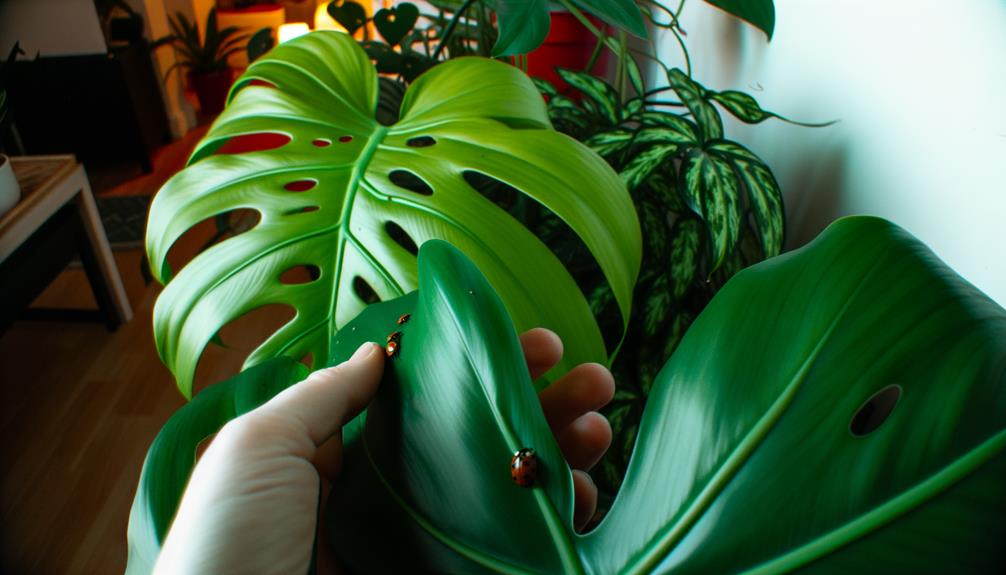
While ensuring best root health through periodic repotting, it’s equally important to vigilantly monitor your Monstera adansonii for common pests and diseases that can impede leaf growth and overall plant importance. Spider mites, mealybugs, aphids, and fungal infections are frequent adversaries. Regular inspection is essential for early detection.
To maintain ideal plant health, follow these steps:
- Inspect leaves and stems weekly for signs of pests like webbing or discolored spots.
- Isolate affected plants immediately to prevent cross-contamination.
- Use insecticidal soaps or neem oil as empirical evidence suggests they’re effective against most pests.
- Ensure proper ventilation and avoid overwatering to mitigate fungal growth.
Conclusion
Think of your Monstera adansonii as an athlete in training. It needs the right light, hydration, nutrition, and coaching to thrive.
By optimizing light conditions, ensuring proper watering, choosing the ideal soil mix, maintaining humidity, following a fertilization schedule, pruning wisely, supporting growth with stakes, repotting strategically, and controlling pests, you’re setting the stage for lush, larger leaves.
Just like an athlete peaks with precise care, your plant will flourish, displaying empirical evidence of your meticulous attention.






